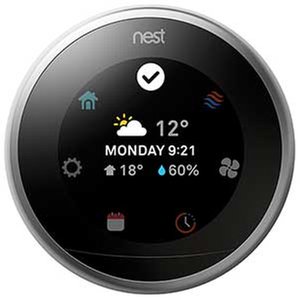
There is something about fathers and thermostats. When I was a kid, my dad was in charge of our house’s thermostat, and anyone caught messing with the temperature was in deep trouble. Once, just for fun, my sister cranked it up by one measly degree, and my dad came running to the living room about 10 minutes later to find out who had been “screwing” with the device. I’m pretty sure he had the thing wired directly to his brain, because how else would he know when we had touched it? His reasoning was that heating or cooling the house used up power, which cost money… and if we were cold we could put on a sweat. Or, in the summer, if we were too hot, then we could strip off some clothes or go to the neighbourhood pool. He was the guardian of the temple of thermostat, and we were infidels who only sought to blaspheme normal temperatures. Or something like that. Today, though, thanks to ever-evolving technology and the Internet of things, fathers no longer have to stand vigil over the dial, because you can save power (and money) through the use of smarthome technology, and specifically smart thermostats.
What is a Smart Thermostat?
So, as you can pretty much assume, a smart thermostat is an automated device for controlling a home’s heating and sometimes air conditioning (depending on the home’s particular setup). The smart device allows users to control the temperature of their homes throughout the day using a pre-set schedule, GPS location and more. So, imagine you can set your downstairs heating to be off during the night while you sleep, and have it turn on just prior to when you get up, so your kitchen is nice and toasty when you go for your morning java. It does all the thinking for you.

What Kind of Products are Out There?
However you want to be in control of your home’s temperature, there’s a smart thermostat that’s ideal for your needs. And there’s a reason these things are called “smart” thermostats. Take the Nest Learning Thermostat, for instance. This device not only lets you control the temps of your home from anywhere (it connects to your home’s WiFi network), but it also learns your habits and schedule, and within a week it starts programming itself to accommodate your needs. It can also send you alerts while monitoring your furnace, and track your energy consumption. The Ecobee3 does all that, and it can also be controlled through voice commands with Apple’s Siri, and can regulate temperatures based on sensing when a room is occupied, versus when no one is at home. Then there’s the Honeywell Lyric Thermostat, which has WiFi connectivity and it can use your phone’s GPS to know when you are close to home so it sets your home temperature for your return. The trick, of course, is to find a unit that you will use consistently, and is versatile enough or simple enough for your needs. For maximum efficiency, you want to make sure you can get the device working so that it heats the home (or parts of the home, depending) when you are there (or starts heating it just before you come home) and is not using energy to heat when you are away or in other parts of the house.
How Much Money can I save?
The main thing to think about when looking into purchasing a smart thermostat system for your home is that this is an investment. You are spending some money so you can save more in the long run, by being more aware and in control of your energy consumption when heating or cooling your home. And how much you will personally save depends on where you live, how harsh the climate is, your schedule, and what your home uses to heat or cool. My fellow blogger Matt has a lot to say on the subject in his Setting up a Smart Home Series Part 4: Saving Money and Energy article. He goes into pretty good detail about how the tech can save you money. And you can even look into some general numbers yourself, as both Nest and Honeywell offer calculators on their web sites that allow you to get a ballpark figure of how much you can save. Manufacturers of these products of course are pretty clear they can only give you estimates, however Ecobee claims you can save an average of 24 per cent in heating, while Nest calls it at about 10 to 12 per cent. Most surveys and research I’ve read so far on the subject peg it at about 10 per cent, if you’re using the tech correctly, that is. And, based on those figures, you won’t see a return on your smart thermostat investment before two or three years of use. But, that is what investing entails, right? Putting something toward the future. So, while you may not see your money back in savings for a couple of years, you just keep on saving after that for years to come. And, no more raging fathers wondering who’s been messing with the temperature. Ahh, progress.



